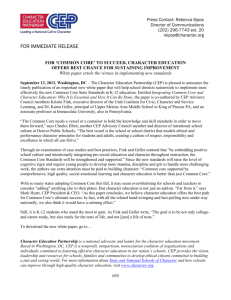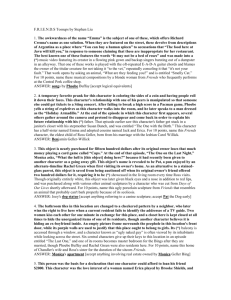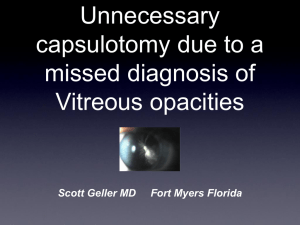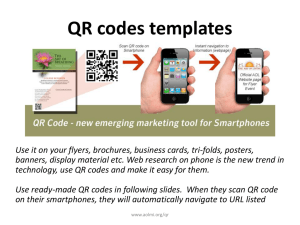Information Transfer under Conditions of Sensory Shielding
advertisement
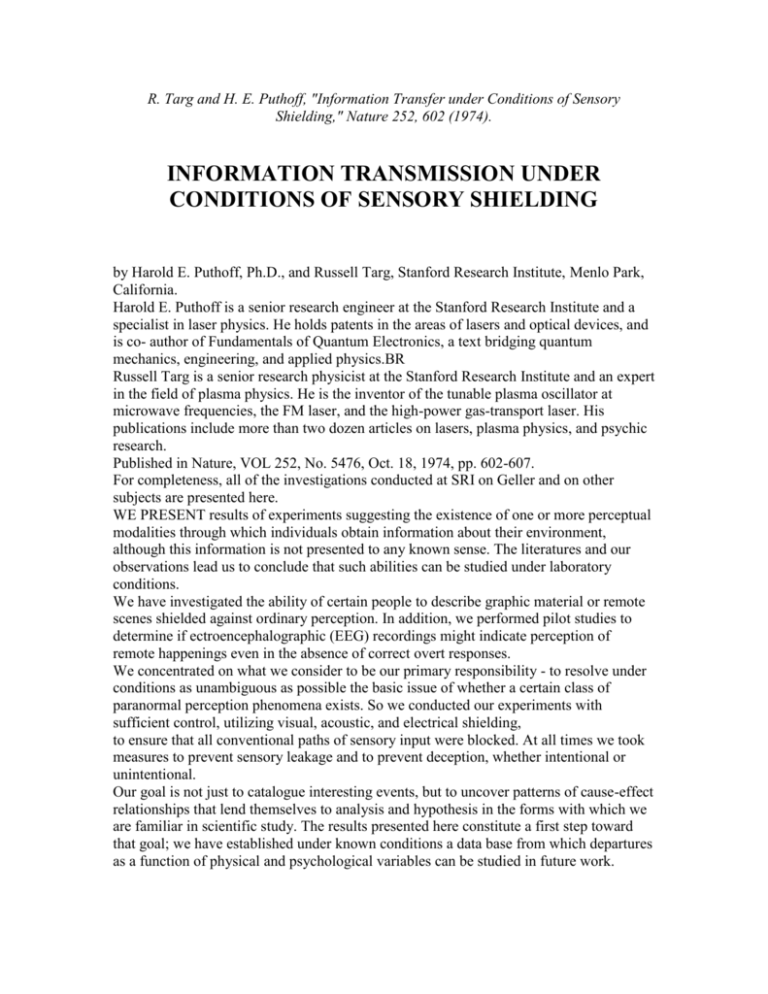
R. Targ and H. E. Puthoff, "Information Transfer under Conditions of Sensory Shielding," Nature 252, 602 (1974). INFORMATION TRANSMISSION UNDER CONDITIONS OF SENSORY SHIELDING by Harold E. Puthoff, Ph.D., and Russell Targ, Stanford Research Institute, Menlo Park, California. Harold E. Puthoff is a senior research engineer at the Stanford Research Institute and a specialist in laser physics. He holds patents in the areas of lasers and optical devices, and is co- author of Fundamentals of Quantum Electronics, a text bridging quantum mechanics, engineering, and applied physics.BR Russell Targ is a senior research physicist at the Stanford Research Institute and an expert in the field of plasma physics. He is the inventor of the tunable plasma oscillator at microwave frequencies, the FM laser, and the high-power gas-transport laser. His publications include more than two dozen articles on lasers, plasma physics, and psychic research. Published in Nature, VOL 252, No. 5476, Oct. 18, 1974, pp. 602-607. For completeness, all of the investigations conducted at SRI on Geller and on other subjects are presented here. WE PRESENT results of experiments suggesting the existence of one or more perceptual modalities through which individuals obtain information about their environment, although this information is not presented to any known sense. The literatures and our observations lead us to conclude that such abilities can be studied under laboratory conditions. We have investigated the ability of certain people to describe graphic material or remote scenes shielded against ordinary perception. In addition, we performed pilot studies to determine if ectroencephalographic (EEG) recordings might indicate perception of remote happenings even in the absence of correct overt responses. We concentrated on what we consider to be our primary responsibility - to resolve under conditions as unambiguous as possible the basic issue of whether a certain class of paranormal perception phenomena exists. So we conducted our experiments with sufficient control, utilizing visual, acoustic, and electrical shielding, to ensure that all conventional paths of sensory input were blocked. At all times we took measures to prevent sensory leakage and to prevent deception, whether intentional or unintentional. Our goal is not just to catalogue interesting events, but to uncover patterns of cause-effect relationships that lend themselves to analysis and hypothesis in the forms with which we are familiar in scientific study. The results presented here constitute a first step toward that goal; we have established under known conditions a data base from which departures as a function of physical and psychological variables can be studied in future work. Remote Perception of Graphic Material First, we conducted experiments with Mr. Uri Geller in which we examined his ability, while located in an electrically shielded room, to reproduce target pictures drawn by experimenters located at remote locations. Second, we conducted double-blind experiments with Mr. Pat Price, in which we measured his ability to describe remote outdoor scenes many miles from his physical location Finally, we conducted preliminary tests, using EEGs, in which subjects were asked to perceive whether a remote light was flashing, and to determine whether a subject could perceive the presence the light, even if only at a non-cognitive level of awareness. In preliminary testing Geller apparently demonstrated an ability to reproduce simple pictures (line drawings) that had been drawn and placed in opaque sealed envelopes he was not permitted to handle. But since each of the targets was known to at least one experimenter in the room with Geller, it was not possible on the basis of the preliminary testing to discriminate between Geller's direct perception of envelope contents and perception through some mechanism involving the experimenters, whether paranormal or subliminal. So we examined the phenomenon under conditions designed to eliminate all conventional information channels, overt or subliminal. Geller was separated from both the target material and anyone knowledgeable of the material, as in the experiments of Reference 4. In the first part of the study a series of thirteen separate drawing experiments was carried out over seven days. No experiments were deleted from the results presented here. (For all target drawings and Geller's responses see Plates 1 and 2.) At the beginning of the experiment either Geller or the experimenters entered a shielded room, so that from that time forward Geller was at all times visually, acoustically, and electrically shielded from personnel and material at the target location. Only following Geller's isolation from the experimenters was a target chosen and drawn, a procedure designed to eliminate pre-experiment cueing. Furthermore, to eliminate the possibility of pre-experiment target forcing, Geller was kept ignorant as to the identity of the person selecting the target and as to the method of target selection. This was accomplished by the use of three different techniques: (1) pseudorandom technique of opening a dictionary arbitrarily and choosing the first word that could be drawn (Experiments 1-4); (2) targets, blind to experimenters and subject, prepared independently by SRI scientists outside the experimental group (following Geller's isolation) and provided to the experimenters during the course of the experiment (Experiments 5-7, 11-13); and (3) arbitrary selection from a target pool decided upon in advance of daily experimentation and designed to provide data concerning information content for use in testing specific hypotheses (Experiments 8-10). Geller's task was to reproduce with pen on paper the line drawing generated at the target location. Following a period of effort ranging from a few minutes to half an hour, Geller either passed feel confident) or indicated he was ready to submit a drawing to the experimenters,in which case the drawing was collected before Geller was permitted to see the target. Table 1. Summary: Remote perception of graphic material Experiment Date Geller Location Target location Target Figure 1 8/4/73 Shielded room #1 *a Adjacent room(4.1 m) *b Firecracker 1a 2 8/4/73 Shielded room #1 Adjacent room(4.1 m) Grapes 1b 3 8/5/73 Shielded room #1 Office (475 m) Devil 1c 4 8/5/73 Room adjacent to Shielded room #1 Shielded room#l (3.2 m) Solar system 1d 5 8/6/73 Room adjacent to Shielded room #1 Shielded room#l (3.2 m) Rabbit No drawing 6 8/7/73 Shielded room #1 Adjacent room(4.1 m) Tree No drawing 7 8/7/73 Shielded room #1 Adjacent room(4.1 m) Envelope No drawing 8 8/8/73 Shielded room #1 Remote room (6.75m) Camel 1e 9 8/8/73 Shielded room #1 Adjacent room(4.1 m) Bridge 1f 10 8/8/73 Shielded room #1 Adjacent room(4.1 m) Seagull 1g 11 8/9/73 Shielded room #2 *c Computer (54 m)(computer CRT) Kite 2a 12 8/10/73 Shielded room #2 Computer (54 m) (computer memory) Church 2b 13 8/10/73 Shielded room #2 Computer (54 m) (computer CRT, zero intensity) Arrow 2c through heart (a)EEG Facility shielded room (see text). (b)Perceiver-target distances measured in meters. (c)SRI Radio Systems Laboratory shielded room (see text). To prevent sensory cueing of the target information, Experiments 1 through 10 were carried out using a shielded room in SRI's facility for EEG research. The acoustic and visual isolation is provided by a double-walled steel room, locked by means of an inner and outer door, each of which is secured with a refrigerator-type locking mechanism. Following target selection when Geller was inside the room, a one-way audio monitor, operating only from the inside to the outside, was activated to monitor Geller during his efforts. The target picture was never discussed by the experimenters after the picture was drawn and brought near the shielded room. In our detailed examination of the shielded room and the protocol used in these experiments, no sensory leakage has been found. The conditions and results for the ten experiments carried out in the shielded room are displayed in Table 1 and Plate 1. All experiments except 4 and 5 were conducted with Geller inside the shielded room. In Experiments 4 and 5, the procedure was reversed. For those experiments in which Geller was inside the shielded room, the target location was in an adjacent room at a distance of about 4 m, except for Experiments 3 and 8, in which the target locations were, respectively, an office at a distance of 475 m and a room at a distance of about 7 m. A response was obtained in all experiments except Numbers 5-7. In Experiment 5, the person-to-person link was eliminated by arranging for a scientist outside the usual experimental group to draw a picture, lock it in the shielded room before Geller's arrival at SRI, and leave the area. Geller was then led by the experimenters to the shielded room and asked to draw the picture located inside the room. He said that he got no clear impression and therefore did not submit a drawing. The elimination of the person-toperson link was examined further in the second series of experiments with this subject. Experiments 6 and 7 were carried out while we attempted to record Geller's EEC during his efforts to perceive the target pictures. The target pictures were, respectively, a tree and an envelope. He found it, difficult to hold adequately still for good EEG records, said that he experienced difficulty in getting impressions of the targets, and again submitted no drawings. Experiments 11-13 were carried out in SRI's Engineering Building, to make use of the computer facilities available there. For these experiments, Geller was secured in a double-walled, Copper-screen Faraday cage 54 m down the hall and around the corner from the computer room. The Faraday cage provides 120 dB attenuation for plane wave radio frequency radiation over a range of 15 kHz to 1 GHz. For magnetic fields the attenuation is 68 dB at 15 kHz and decreases to 3 dB at 60 Hz. Following Geller's isolation, the targets for these experiments were chosen by computer laboratory personnel not otherwise associated with either the experiment or Geller, and the experimenters and subject were kept blind as to the contents of the target pool. For Experiment 11, a picture of a kite was drawn on the face of cathode-ray tube display screen, driven by the computer's graphics program. For Experiment 12, a picture of a church was drawn stored in the memory of the computer. In Experiment 13, target drawing, an arrow through a heart (see Plate 2(c)), was drawn on the face of the cathoderay tube and then the display in was turned off so that no picture was visible. To obtain an independent evaluation of the correlation between target and response data, the experimenters submitted the data for judging on a "blind" basis by two SRI scientists who were not otherwise associated with the research. For the ten cases in which Geller provided a response, the judges were asked to match the response data with the corresponding target data (without replacement). In those cases in which Geller made more than one drawing as his response to the target, all the drawings were combined as a set for judging. The two judges each matched the target data to the response data with no error. For either judge such a correspondence has an a priori probability, under the null hypothesis of no information channel, of P = 1/(10!) = 3 X 10-7. A second series of experiments was carried out to determine whether direct perception of envelope contents was possible without some person knowing of the target picture. One hundred target pictures of everyday objects were drawn by an SRI artist and sealed by other SRI personnel in double envelopes containing black cardboard. The hundred targets were divided randomly into groups of twenty for use in each of the three days' experiments. On each of the three days of these experiments, Geller passed. That is, he declined to associate any envelope with a drawing that he made, expressing dissatisfaction with the existence of such a large target pool. On each day he made approximately twelve recognizable drawings, which he felt were associated with the entire target pool of 100. On each of the three days, two of his drawings could reasonably be associated with two of the twenty daily targets. On the third day, two of his drawings were very close replications of two of that day's target pictures. The drawings resulting from this experiment do not depart significantly from what would be expected by chance. In a simpler experiment Geller was successful in obtaining information under conditions in which no persons were knowledgeable of the target. A double-blind experiment was performed in which a single 3/4-inch die was placed in a 3 x 4 x 5-inch steel box. The box was then vigorously shaken by one of the experimenters and placed on the table, a technique found in control runs to produce a distribution of die faces that does not differ significantly from chance distribution. The orientation of the die within the box was unknown to the experimenters at that time. Geller would then write down which die face was uppermost. The target pool was known, but the targets were individually prepared in a manner blind to all persons involved in the experiment. This experiment was performed ten times, with Geller passing twice and giving a response eight times. The eight times he gave a response, he was correct each time. The distribution of responses consisted of three twos, one four, two fives, and two sixes. The probability of this occurring by chance is approximately one in 10^6. In certain situations significant information transmission can take place under shielded conditions. Factors that appear to be important and are therefore candidates for future investigation include whether the subject knows the set of targets in the target pool, the actual number of targets in the target pool at any given time, and whether the target is known by any of the experimenters. It has been widely reported that Geller has demonstrated the ability to bend metal by paranormal means. Although metal bending by Geller has been observed in our laboratory, we have not been able to combine such observations with adequately controlled experiments to obtain data sufficient to support the paranormal hypothesis. Remote Viewing of Natural Targets A study by Osis (5) led us to determine whether a subject could describe randomly chosen geographical sites located several miles from the subject's position and demarcated by some appropriate means (remote viewing). This experiment carried out with Price, a former California police commissioner and city councilman, consisted of a series of double-blind, demonstration-of-ability tests, involving local targets in the San Francisco Bay area, which could be documented by several independent judges. We planned the experiment believing that natural geographical, places or manmade sites that have existed for a long time are more potent targets, for paranormal perception experiments than are artificial targets prepared in the laboratory. This is based on subject opinions that the use of artificial targets involves a "trivialization of the ability" as compared with natural preexisting targets. In each of nine experiments involving Price as subject and SRI experimenters as a targetdemarcation team, a remote location was chosen in a double-blind protocol. Price, who remained at SRI, was asked to describe this remote location, as well as whatever activities might be going on there. Several descriptions yielded significantly correct data pertaining to, and descriptive of, the target location. In the experiments a set of twelve target locations clearly differentiated from each other and within thirty minutes' driving time from SRI had been chosen from a target-rich environment (more than 100 targets of the type used in the experimental series) prior to the experimental series by an individual in SRI management, the director of the Information Science and Engineering Division, not otherwise associated with the experiment. Both the experimenters and the subject were kept blind as to the contents of the target pool, which were used without replacement. An experimenter was closeted with Price at SRI to wait thirty minutes to begin the narrative description of the remote location. The SRI locations from which the subject viewed the remote locations consisted of an outdoor park (Experiments 1 and 2), the double-walled copper-screen Faraday cage discussed earlier (Experiments 3 and 4, and 69), and an office (Experiment 5). A second experimenter would then obtain a target location from the division director from a set of traveling orders previously prepared and randomized by the director and kept under his control. The target demarcation team (two to four SRI experimenters) then proceeded directly to the target by automobile without communicating with the subject or experimenter remaining behind. Since the experimenter remaining with the subject at SRI was in ignorance both as to the particular target and as to the target pool, he was free to question Price to clarify his descriptions. The demarcation team then remained at the target site for thirty minutes after the thirty minutes allotted for travel. During the observation period, the remote-viewing subject would describe his impressions of the target site into a tape recorder. A comparison was then made when the demarcation team returned. Price's ability to describe correctly buildings, docks, roads, gardens, and so on, including structural materials, color, ambiance, and activity, sometimes in great detail indicated the functioning of a remote perceptual ability. But the descriptions contained inaccuracies as well as correct statements. To obtain a numerical evaluation of the accuracy of the remote viewing experiment, the experimental results were subjected to independent judging on a blind basis by five SRI scientists who were not otherwise associated with the research. The judges were asked to match the nine locations, which they independently visited, against the typed manuscripts of the tape-recorded narratives of the remote viewer. The transcripts were unlabeled and presented in random order. The judges were asked to find a narrative that they would consider the best match for each of the places they visited. A given narrative could be assigned to more than one target location. A correct match required that the transcript of a given date be associated with the target of that date. Table 2 shows the distribution of the judges' choices. Table 2. Distribution of correct selections by judges A,B,C,D, and E In remote viewing experiments Descriptions chosen by judges Places visited by judges 1 2 3 4 5 6 7 8 9 Hoover Tower 1 ABCDE D Baylands Nature Preserve 2 ABC E D D Radio Telescope 3 ACD BE Redwood City Marina 4 CD ABDE E Bridge Toll Plaza 5 ABD DCE Drive-in Theater 6 B A c E Arts and Crafts Garden Plaza 7 ABCE Church 8 c AB Rinconada Park 9 CE AB Of the 45 selections (5 judges, 9 choices), 24 were correct. Bold type indicates the description chosen most often for each place visited. Correct choices lie on the main diagonal. The number of correct matches by Judges A through E is 7, 6, 5, 3 and 3, respectively. The expected number of correct matches from the five judges was five; in the experiment 24 such matches were obtained. The a priori probability of such an occurrence by chance, conservatively assuming assignment without replacement on the part of the judges, is P = 8 x 10^-10. Among all possible analyses, the most conservative is a permutation analysis of the plurality vote of the judges' selections, assuming assignment without replacement, an approach independent of the number of judges. By plurality vote, six of the nine descriptions and locations were correctly matched. Under the null hypothesis (no remote viewing and a random selection of descriptions without replacement), this outcome has an a priori probability of P = 5.6 x 10^-4, since, among all possible permutations of the integers one through nine, the probability of six or more being in their natural position in the list has that value. Therefore, although Price's descriptions contain inaccuracies, the descriptions are sufficiently accurate to permit the judges to differentiate among the various targets to the degree indicated. EEG Experiments An experiment was undertaken to determine whether a physiological measure such as EEG activity could be used as an indicator of information transmission between an isolated subject and a remote stimulus. We hypothesized that perception could be indicated by such a measure even in the absence of verbal or other overt indicators. (6,7) It was assumed that the application of remote stimuli would result in responses similar to those obtained under conditions of direct stimulation. For example, when a normal subject is stimulated with a flashing light, his EEG typically shows a decrease in the amplitude of the resting rhythm and a driving of the brain waves at the frequency of the flashes. (8) We hypothesized that if we stimulated one subject (a sender) in this manner, the EEG of another subject (a receiver) in a remote room with no flash present, might show changes in alpha (9-11 Hz) activity, and possibly EEG driving similar to that of the sender. We informed our subject that at certain times a light was to he flashed in a sender's eyes in a distant room, and if the subject perceived that event, consciously or unconsciously, it might be evident from changes in his EEG output. The receiver was seated in the visually opaque, acoustically and electrically shielded double walled steel room previously described. The sender was seated in a room about 7 m from the receiver. To find subjects who were responsive to such a remote stimulus, we initially worked with four female and two male volunteer subjects, all of whom believed that success in the experimental situation might be possible. These were designated "receivers." The senders were either other subjects or the experimenters. We decided beforehand to run one or two sessions of thirty-six trials each with each subject in this selection procedure, and to do a more extensive study with any subject whose results were positive. A Grass PS-2 photostimulator placed about 1 m in front of the sender was used to present flash trains of ten-seconds' duration. The receiver's EEG activity from the occipital region (Oz), referenced to linked mastoids, was amplified with a Grass 5P-1 preamplifier and associated driver amplifier with a band pass of 1-120 Hz. The EEG data were recorded on magnetic tape with an Ampex SP 300 recorder. On each trial, a tone burst of fixed frequency was presented to both sender and receiver and was followed in one second by either a ten-second train of flashes or a null flash interval presented to the sender. Thirty-six such trials were given in an experimental session, consisting of twelve null trials - no flashes following the tone - twelve trials of flashes at six flashes per second and twelve trials of flashes at sixteen flashes per second, all randomly intermixed, determined by entries from a table of random numbers. Each of the trials generated an eleven-second EEG epoch. The last four seconds of the epoch were selected for analysis to minimize the desynchronizing action of the warning cue. This four-second segment was subjected to Fourier analysis on a LINC 8 computer. Spectrum analyses gave no evidence of EEG driving in any receiver, although in control runs the receivers did exhibit driving when physically stimulated with the flashes. But of the six subjects studied initially, one subject (H.H.) showed a consistent alpha blocking effect. We therefore undertook further study with this subject. Data from seven sets of thirty-six trials each were collected from this subject on three separate days. This is all the data collected to date with this subject under the test conditions described above. The alpha band was identified from average spectra; then scores of average power and peak power were obtained from individual trials and subjected to statistical analysis. Table 3. EEG data for H. H. showing average power and peak power in the 9-11 Hz band, as a function of flash frequency and sender Flash Frequency 0 6 16 0 6 16 Sender Average power Peak power J.L 94.8 84.1 76,8 357.7 329.2 289.6 R.T. 41.3 45.5 37.0 160.7 161.0 125.0 No sender (subject informed) 25.1 35.7 28.2 87.5 95.7 81.7 J.L. 54.2 55.3 44.8 191.4 170.5 149.3 J.L. 56.8 50.9 32,8 240.6 178.0 104.6 R.T. 39.8 24.9 30.3 145.2 74.2 122.1 No sender (subject not informed) 86.0 53.0 52.1 318.1 180.6 202.3 Averages 56.8 49.9 43.1 214.5 169.8 153.5 -12% -24%(P0.04) -21% -28%(P0.03) Each entry is an average over 12 trials Of our six subjects, H.H. had by far the most monochromatic EEG spectrum. Plate 3 shows an overlay of the three averaged spectra from one of this subject's thirty-six-trial runs, displaying changes in her alpha activity for the three stimulus conditions. (See Plate 3.) Mean values for the average power and peak power for each of the seven experimental sets are given in Table 3. The power measures were less in the sixteen-flashes-per-second case than in the zero-flashes-per-second in all seven peak power measures and in six out of seven average power measures. Note also the reduced effect in the case in which the subject was informed that no sender was present (Run 3). It seems that overall alpha production was reduced for this run in conjunction with the subject's expressed apprehension about conducting the experiment without a sender. This is in contrast to the case (Run 7) in which the subject was not informed. Siegel's two-tailed t approximation to the nonparametric randomization test (9) was applied to the data from all sets, which included two sessions in which the sender was removed. Average power on trials associated with the occurrence of sixteen flashes per second was significantly less than when there were no flashes (t= 2.09, d.f. = 118, P 0.04). The second measure, peak power, was also significantly less in the sixteen-flashesper-second conditions than in the null condition (t = 2.16, d.f. = 118, P 0.03). The average response in the six-flashes-per-second condition was in the same direction as that associated with sixteen flashes per second, but the effect was not statistically significant. Spectrum analyses of control recordings made from saline with a 12 k ohm resistance in place of the subject with and without the addition of a 10 Hz, 50 micro volt test signal applied to the saline solution, revealed no indications of flash frequencies, nor perturbations of the 10 Hz signal. These controls suggest that the results were not due to system artifacts. Further tests also gave no evidence of radio frequency energy associated with the stimulus. Subjects were asked to indicate their conscious assessment for each trial as to which stimulus was generated. They made their guesses known to the experimenter via one-way telegraphic communication. An analysis of these guesses has shown them to be at chance, indicating the absence of any supraliminal cuing, so arousal as evidenced by significant alpha blocking occurred only at the noncognitive level of awareness. We hypothesize that the protocol described here may prove to be useful as a screening procedure for latent remote perceptual ability in the general population. Conclusion From these experiments we conclude that: 1. A channel exists whereby information about a remote location can be obtained by means of an as yet unidentified perceptual modality. 2. As with all biological systems, the information channel appears to be imperfect, containing noise along with the signal. 3. While a quantitative signal-to-noise ratio in the information theoretical sense cannot as yet be determined, the results of our experiments indicate that the functioning is at the level of useful information transfer. It may be that remote perceptual ability is widely distributed in the general population, but because the perception is generally below an individual's level of awareness, it is repressed or not noticed. For example, two of our subjects (H.H. and P.P.) had not considered themselves to have unusual perceptual ability before their participation in these experiments. Our observation of the phenomena leads us to conclude that experiments in the area of so-called paranormal phenomena can be scientifically conducted, and it is our hope that other laboratories will initiate additional research to attempt to replicate these findings. REFERENCES 1. Pratt, J., J. B. Rhine, C. Stuart, and J. Greenwood, Extrasensory Perception after Sixty Years (New York: Henry Holt, 1940). 2. Soal, S. and F. Bateman, Modern Experiments in Telepathy (London: Faber and Faber, 1954). 3. Vasiliev, L. L., Experiments in Mental Suggestion (Hampshire, England: ISMI Publications, 1963). 4. Musso, J. R. and M. Granero, Journal of Parapsychology, 37, 13-37, 1973. 5. Osis, K., ASPR Newsletter, No. 14, 1972. 6. Tart, C. T., "Physiological Correlates of Psi Cognition." International Journal of Parapsychology, V, No. 4, 1963. 7. Dean, E. D., International Journal of Neuropsychiatry, 2, 1966. 8. Hill, D. and C. Parr, Electroencephalography: A Symposium on Its Various Aspects (New York: Macmillan, 1963). 9. Siegel, S., Nonparametric Statistics for the Behavioral Sciences (New York: McGrawHill, 1956), pp. 152-56.

